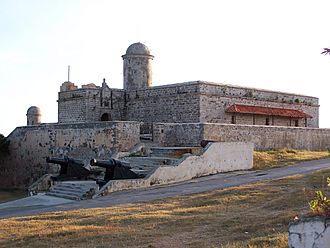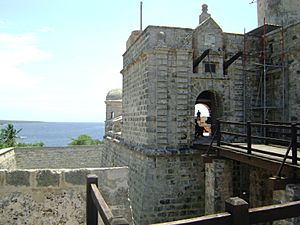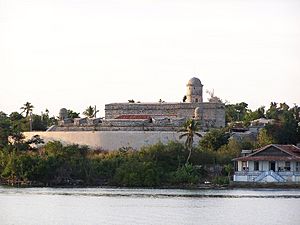Castillo de Jagua facts for kids
Quick facts for kids Castillo de Jagua |
|
|---|---|
 |
|
| General information | |
| Architectural style | Spanish Colonial architecture |
| Town or city | Jagua, Cienfuegos |
| Country | |
| Coordinates | 22°04′N 80°28′W / 22.067°N 80.467°W |
| Completed | 1742 |
The Jagua Fortress (also called Castillo de Jagua in Spanish) is an old fort in Cuba. It stands south of the city of Cienfuegos. You can find it right at the entrance of the Cienfuegos Bay, in the port of Jagua. Its full original name was "Castillo de Nuestra Señora de los Ángeles de Jagua," which means "Castle of Our Lady of the Angels of Jagua."
History of Jagua Fortress
This strong fortress was built by King Philip V of Spain in 1742. Its main job was to protect the bay from pirates. Back then, pirates often sailed the Caribbean Sea. They would use the bay as a safe place to stop. From there, they would go to the area where Cienfuegos city now stands. They needed to gather water, food, and other supplies.
The fort is made from strong limestone. It has several levels and even a well inside. There's also a tall watch tower to spot ships from far away. A moat surrounds the fort, but it was never filled with water. The fortress also has a working drawbridge. This is one of the few drawbridges left that still works perfectly.
The city of Cienfuegos was founded later, in 1819, by French settlers. It grew near the Jagua Bay. Because of the fortress guarding its harbor, Cienfuegos became a very important trading center. This was true for the central part of Cuba during the time it was a colony. Even today, the port of Cienfuegos is still vital for Cuba's economy.
The Jagua Fortress is a famous example of Cuba's old colonial buildings. It has even been shown on money! In the 1980s, a special 10-peso banknote featured a beautiful drawing of the castle on its back. This helped people remember this amazing piece of history.
See also
 In Spanish: Fortaleza de Jagua para niños
In Spanish: Fortaleza de Jagua para niños
- Historic Centre of Cienfuegos
- Jardín Botánico de Cienfuegos
- Juraguá
- Juragua Nuclear Power Plant



